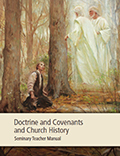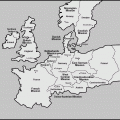The Church of Jesus Christ of Latter-day Saints, whose members are sometimes nicknamed Mormons, have released a new lesson manual for Mormon high school students. The manual covers church history and is used in a program called Seminary, which is taught on school days. It is more academic than Sunday School and covers scriptures and church history in far more depth, since it is taught five days a week.
 The new manual introduces many controversial subjects previously reserved for the Institute of Religion, a program similar to Seminary, but taught to college students. None of the material is a surprise to church members who study their faith, but it may be new to teenagers. The topics are those often introduced by—and often misrepresented by—people who desire to attack the Church. Teenagers today find that material on the Internet and so the Church has made dramatic changes to its youth program to help prepare teenagers to encounter this material. They are teaching the topics in official classes and also teaching teenagers how to do authentic research on the subjects in order to find answers on their own. They are also taught to recognize bias and to understand the motives of people who devote their lives to tearing down instead of building up.
The new manual introduces many controversial subjects previously reserved for the Institute of Religion, a program similar to Seminary, but taught to college students. None of the material is a surprise to church members who study their faith, but it may be new to teenagers. The topics are those often introduced by—and often misrepresented by—people who desire to attack the Church. Teenagers today find that material on the Internet and so the Church has made dramatic changes to its youth program to help prepare teenagers to encounter this material. They are teaching the topics in official classes and also teaching teenagers how to do authentic research on the subjects in order to find answers on their own. They are also taught to recognize bias and to understand the motives of people who devote their lives to tearing down instead of building up.
The new manual includes instruction on the nine known accounts of the First Vision, in which a teenage Joseph Smith turned to God in prayer to know which church is true.
Learn more about Joseph Smith.
They learn that four were written by Joseph Smith or dictated by him. The others were second-hand accounts by other people. Each one was written for a specific purpose and a specific audience, and so it targeted the needs of the account. As a writer and speaker, I do the same thing. I have a long story I tell about the first class of children I taught at church. I never tell the entire story. The portions I choose to share, the way the story is told, and the details I include depend on the audience and purpose for sharing the story. I have told the story in three different “moral of the story” versions: how priesthood blessings work, the power of love in teaching, and developing our talents. Each version is different, but the story is still true.
In this lesson, they are taught how to seek authentic answers about this issue or any other controversial issue.
“Latter-day Saint readers should … be … sophisticated in their evaluation of what they read. …
“Our individual, personal testimonies are based on the witness of the Spirit, not on any combination or accumulation of historical facts. If we are so grounded, no alteration of historical facts can shake our testimonies. Our Heavenly Father gave us powers of reason, and we are expected to use them to the fullest. But he also gave us the Comforter, who he said would lead us into truth and by whose power we may know the truth of all things. That is the ultimate guide for Latter-day Saints who are worthy and willing to rely on it” (“Reading Church History” [address to CES religious educators, Aug. 16, 1985], 7, LDS.org).
Students who want to learn more are directed to several articles written by LDS scholars, including the esteemed Richard Bushman, Gouverneur Morris Professor of History emeritus at Columbia University.
Mountain Meadows Massacre and the Utah War
 Teenagers are given an in-depth study of the Mountain Meadows Massacre, which is remarkable in that it helps the students to see the events from the perspective of both sides. Empathy and learning to see things from another person’s perspective is a valuable life skill. They are shown that the Mormon settlers failed to follow gospel instruction to settle differences quickly in order to avoid escalation and asked to evaluate how history might have been different if the settlers had been obedient to gospel teachings.
Teenagers are given an in-depth study of the Mountain Meadows Massacre, which is remarkable in that it helps the students to see the events from the perspective of both sides. Empathy and learning to see things from another person’s perspective is a valuable life skill. They are shown that the Mormon settlers failed to follow gospel instruction to settle differences quickly in order to avoid escalation and asked to evaluate how history might have been different if the settlers had been obedient to gospel teachings.
Students learn that although it took time for church leaders to learn the full details of what happened, since it occurred a week’s journey from Salt Lake City, once the investigation was complete, local leaders who were responsible for the massacre were released from their positions and two were excommunicated. Nine men were criminally indicted, and except for the few who escaped, were arrested, although only one was found guilty and executed for his role. They are taught that the Church has condemned the actions of those Mormons who were involved.
Additional subjects covered in the new manual include:
-
Pearl of Great Price (a small book of Mormon scripture)
-
Polygamy beginning with Joseph Smith and also covering polygamy that continued after it was officially stopped
-
The Joseph Smith translation of the Bible
-
The priesthood ban on Black Mormons
-
The age of the Earth
The lesson manual is part of a powerful new curriculum for teenagers. When the bar was raised for missionary service, and again when the age was lowered, it became clear that teens needed to be better prepared for missionary service and adulthood. Sunday instruction for teenagers has also changed to help with that preparation.
 After Sunday worship service, Mormons continue on to attend two classes, with church lasting three hours altogether. Mormon teens attend Sunday school in an age-based class that has girls and boys learning together. Then they separate for age-based and gender-based classes. The new model for these classes no longer uses a lecture and discussion format as is commonly found in traditional schools. Instead, the teacher serves as a moderator and mentor. Each month is assigned a gospel theme that is covered in both classes. Teachers select among a number of possible topics for that theme, offered in the form of a question. For instance, in March of this year, students will study the atonement of Jesus Christ. Although there are five weeks of instruction that month, teachers have seven questions to choose from. One is, “What is grace?”
After Sunday worship service, Mormons continue on to attend two classes, with church lasting three hours altogether. Mormon teens attend Sunday school in an age-based class that has girls and boys learning together. Then they separate for age-based and gender-based classes. The new model for these classes no longer uses a lecture and discussion format as is commonly found in traditional schools. Instead, the teacher serves as a moderator and mentor. Each month is assigned a gospel theme that is covered in both classes. Teachers select among a number of possible topics for that theme, offered in the form of a question. For instance, in March of this year, students will study the atonement of Jesus Christ. Although there are five weeks of instruction that month, teachers have seven questions to choose from. One is, “What is grace?”
Students are expected to prepare for the lesson in advance, using a list of resources offered online. This is a contrast to the previous method of having students show up expecting to learn the subject in class only. They are asked to think about what portions of their personal study they want to share with their classmates. Class begins by having the students teach each other what they learned during the week of personal study and to initiate conversations on the subject.
Following this, the teacher introduces the subject and asks what questions the teens have about the topic. He or she is then able to guide the teenagers in finding answers to those question, rather than merely answering the questions for them. The teacher selects from a number of methods for introducing the day’s research. The students then work in small groups to find answers to their questions and to share the results.
At the end of class, they are challenged to select a way to have a personal experience with the subject during the coming week and the students decide if they need another week to investigate this topic or if they are ready to move on.
This method teaches them to become self-directed learners. It is impossible to learn everything in a few hours of church instruction. Unlike participants in some churches, Mormons come to church to be uplifted and motivated, but are then expected to delve more deeply into topics of study at home. Church is supposed to be the starting point, not the full course of study. Mormons are encouraged to participate in daily personal and family scripture and gospel study, as well as daily prayer.
Although teens are sometimes told by outsiders that Mormons hide their history, they will quickly learn that this is not true. The outside sources to which they are referred are found in official sources, such as church magazines and the church website, and most originated many years ago. While some Mormons may not know about these topics, it is only because they have not taken advantage of the materials provided them. Understanding this will help them to recognize that others are attempting to mislead them with false information and give them the skills and resources to investigate on their own using authentic sources.
While many churches are focusing more and more on making church fun for teenagers, Mormons realize this is a path to possible apostasy or at least a watering down of true religion. Today’s teenagers are sophisticated and intelligent, and we need to help them use both their minds and their faith to make decisions about life and eternity. Mormons expect a great deal of their teenagers, who are allowed to give sermons in children’s programs starting at age three, and in the adult services at age twelve. They are given significant responsibilities and leadership roles as teenagers and the Church is helping to prepare them for this great work they do.
Read the new Church history manual for Mormon teens.
Source:
A New Church History Seminary Manual, Fair Mormon Blog
About Terrie Lynn Bittner
The late Terrie Lynn Bittner—beloved wife, mother, grandmother, and friend—was the author of two homeschooling books and numerous articles, including several that appeared in Latter-day Saint magazines. She became a member of the Church at the age of 17 and began sharing her faith online in 1992.



